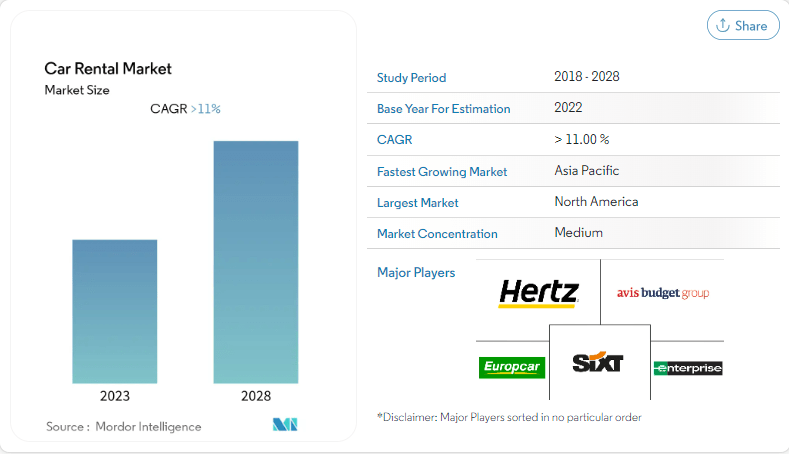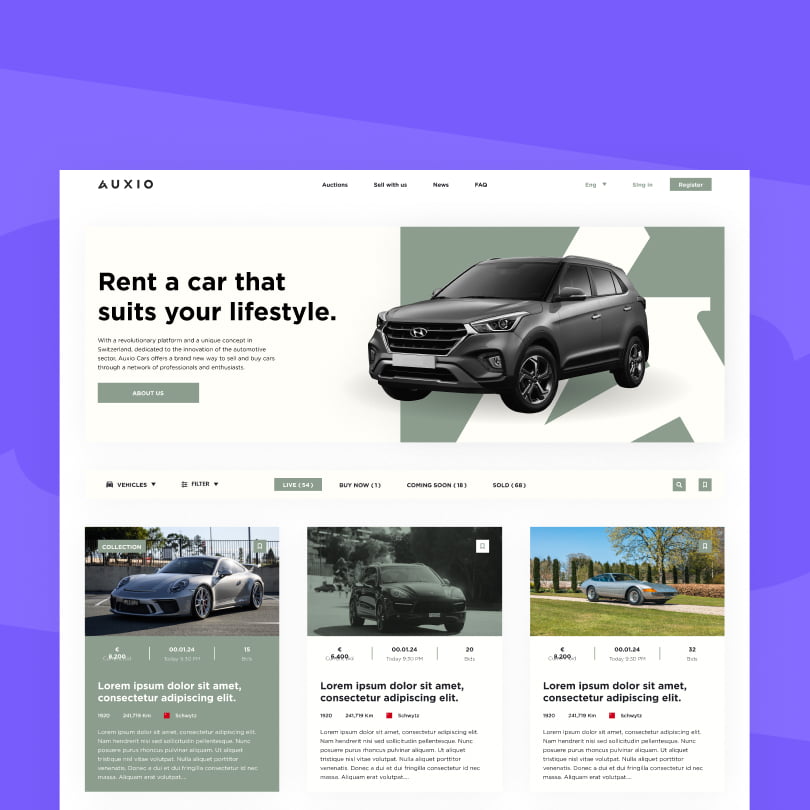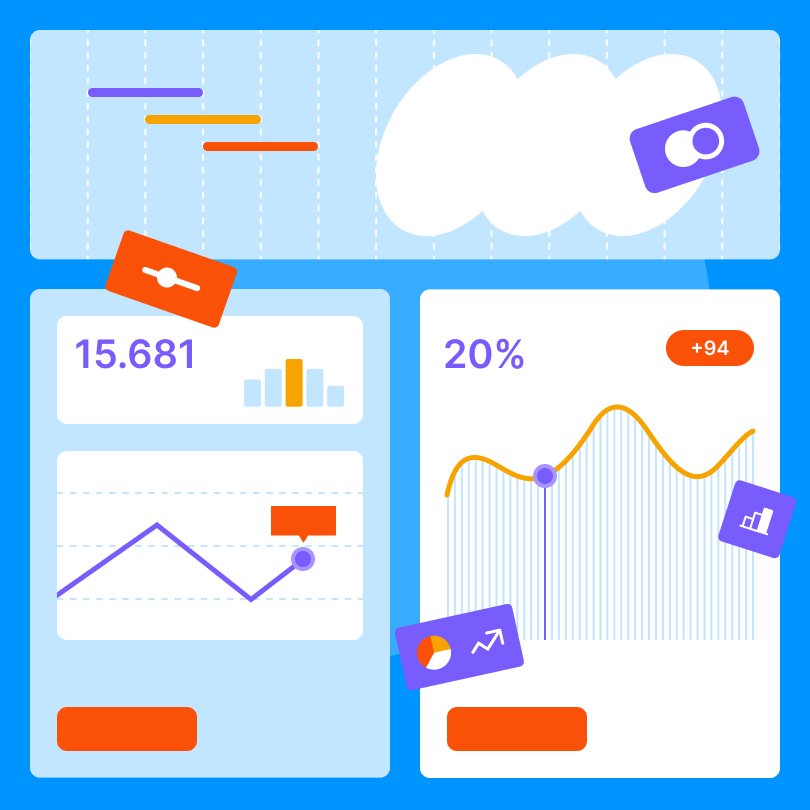Creating a rent-a-car website should be a priority if you are involved in this business, as modern users expect the entire booking process to be easy, fast, and feasible in one place. Car rental is becoming an increasingly profitable business, but the website significantly influences business results.
Market research company Mordor Intelligence estimates that by 2027, the car rental market could reach up to $223.07 billion. Several factors have contributed to this growth, and one of them is the fact that younger generations are more inclined towards renting rather than buying due to costs, as well as the obligations that come with owning a car.

Why Website Development for Rent-A-Car is Important
A website for your car rental business offers a professional online presence, conveniences for clients, and an opportunity to expand your reach and enhance your business in a competitive market.
Specifically, a website has several important roles for a car rental business without which significant success cannot be achieved.
- Online presence: In today’s digital age, an online presence is crucial for any business. A web presentation allows potential clients to find and get informed about your car rental services from anywhere and at any time. When potential clients search for car rentals online, having a website increases the chances of your company appearing in search engine results, attracting more organic traffic to your site.
- Rental information: A website serves as an informative tool that provides answers to frequently asked questions, rental policies, terms and conditions, insurance options, and other relevant information. This reduces the need for customers to contact you about basic inquiries, saving time for both parties.
- 24/7 availability: Unlike a physical location, a web location is available at all times. Potential customers can browse your car inventory, check availability, and make car reservations outside regular working hours.
- Easy reservation: A website allows customers to easily search for available vehicles, view prices and rental terms, as well as make online reservations. This convenience improves the user experience and increases the chances of receiving more reservations.
- Showcasing the car inventory: An online presentation can display your entire car inventory with detailed descriptions, pictures, and specifications. This helps potential customers make informed decisions and choose the right vehicle for their needs.
- Online payment: An online payment system enables your clients to complete the entire car rental process quickly and in one place, without additional administrative requirements.
- Reviews: A website provides customers the opportunity to leave reviews about their experience with your car rental service. Positive reviews help build trust and credibility, encouraging others to choose your company over competitors.
- Marketing and advertising: In addition to a range of services directly related to the car rental process, a website also serves as a marketing tool. You can promote special offers, discounts, and seasonal deals on your site, attracting new clients.
- Analytics and insights into business results: With a website, you can collect data and analyze user behavior, allowing you to make data-driven decisions. This helps you better understand your customers and tailor your services according to their needs.
How to Create a Car Rental Website – Steps
A website for car rental is not a static web page that these days anyone can create using numerous tools, but without programming experience. Rent-a-car web development services are a more complex task because they require configuring a range of functions that online car rental demands. Therefore, it is necessary to turn to experts, marketing and IT companies that can create a website that fully meets the needs of the target audience.
To understand what the website creation process looks like and what you, as a business owner, need to prepare when meeting with programmers, we will present detailed steps below.
1. Create a vision of your website
To obtain a website that serves your goals and business specifics, a necessary step before development is to consider what requests from the clients the website should fulfill, list them, and possibly sketch the website’s structure. You can follow these steps:
- Define the target audience and the types of vehicles you will offer for rental
- Identify key features and functions that would meet the needs of the target group
- Consider all unique aspects of your business that would be integrated into the website
2. Market and Competition Research
The first step that the team of developers in a marketing and IT agency will undertake is researching your target audience and competition. This is a necessary step in order to gain a better understanding of potential clients and create a website that meets their demands based on that understanding. During such research, previously published studies can be used, as well as conducting new research on networks and forums visited by the target audience.
Researching the competition involves reviewing domestic and international car rental websites to gain inspiration for a new one, as well as to introduce specific features that competitor companies do not have.
3. Planning the Website Structure and Navigation
Planning and designing the navigation for a car rental website is crucial to ensure that users can easily find the information they need and navigate through the site efficiently.
Several key elements need to be satisfied/considered for website navigation:
- Clear and simple structure: It is important to create a clear and simple navigation structure that is easy to understand. For that reason, a logical hierarchy is used to organize different sections of the website. Typically, a car rental website may include sections such as the homepage, vehicles, reservations, locations, about us, and contact.
- Homepage: The homepage should serve as a central hub, providing an overview of the rent-a-car service and highlighting key features. An intuitive navigation menu should be created at the top or side of the page so the users could easily navigate to the other parts of the website.
- Vehicle categories: Create a dedicated “vehicles” section where users can browse and select the type of car they are interested in renting. Consider categorizing vehicles based on factors such as size, type (e.g., sedan, SUV, van), and features (e.g., luxury, economy). Include clear and visually appealing icons or images representing each vehicle category.
- Reservation process: The reservation process should be made easily accessible and straightforward by introducing a prominent “reservations” section. It is helpful to provide a step-by-step guide explaining how to make a reservation, as any confusion could discourage users from completing the process. Additionally, the call-to-action button should be placed in multiple locations on the website to ensure it is always “within arm’s reach” for potential customers.
4. Website Development
When it comes to creating the website itself, there are two options. It is possible to choose one of the existing platforms where you need to implement the content for your specific website, or you can create a website without using any ready-made platforms, by coding.
Coding a website requires more time and resources, but provides you with a unique and reliable platform for your business. Using pre-designed templates (Content Management System, CMS) is a common practice, but there are several limiting factors as the navigation and design of your site must be adapted to that pre-designed system.
The most popular CMS platforms for website development are WordPress, Joomla, and Drupal.
- WordPress: WordPress is the most popular CMS known for its user-friendliness and flexibility. It offers numerous themes and plugins specifically designed for car rental websites, making it relatively easy for configuring and managing content. Plugins can be used to enable specific features relevant to the car rental industry – vehicle listing management, reservations, pricing, and availability.
- Joomla: Joomla is another popular CMS that provides flexibility and scalability. With an extensive collection of add-ons and templates, it is possible to customize the car rental website to a certain extent to meet your specific needs. For example, Joomla extensions like “vehicle manager” or a plugin for handling car rental functions can be found.
- Drupal: Drupal is a CMS suitable for complex car rental websites. It offers a high level of customization and scalability, making it suitable for websites with specific requirements. It also has useful add-ons for car rental sites that can be used to facilitate the reservation process.
5. Car Rental Website Design
The design of a car rental website encompasses various visual elements that contribute to its overall attractiveness and functionality.
The choice of colors, patterns, and textures enhances the visual appeal of the page. It is necessary to carefully select a color palette in line with the brand’s identity, using bold and vibrant shades that convey a sense of reliability and professionalism.
The selection of typography should focus on readability, utilizing modern fonts to create a visual hierarchy. In addition to that, visual elements such as high-quality car images, icons, and illustrations enrich the user interface.
A user-friendly car listing section is crucial. Each car listing should include clear, high-resolution images accompanied by essential details such as the brand, model, and available features.

Functions That a Car Rental Website Should Fulfill
As evident from the information above, a car rental website is not solely an informative website where users mainly satisfy their informational needs. It falls into the category of websites where a specific request is executed, such as booking a flight or a hotel room.
Therefore, creating a rent-a-car website necessarily implies the creation of a range of functions that should meet the users’ needs.
- User registration and authentication: Enables users to create accounts, log in, and manage their profiles. This function allows for a personalized experience and provides the ability to track reservations.
- Search and filters: It is necessary to implement a search function with filters in order to assist users in finding specific rental cars based on their preferences, such as location, price range, car type, and similar specific characteristics.
- Advanced search and recommendations: In a competitive industry such as car rental, the details that differentiate you from the competition are important. Therefore, implement advanced search features, like saved searches and favorite examples from the entire inventory.
- Reservation system: Enable users to check vehicle availability, make reservations for it, and manage their bookings online. This function should include a calendar display, booking confirmation, payment integration, and the ability to cancel reservations and receive refunds.
- Messaging and communication: A car rental website should also include a communication system, enabling interested clients to ask questions quickly and easily. Since modern users do not want to wait for a long time for a response, chatbots with pre-prepared answers to frequently asked questions can be helpful.
- Support for multiple languages and currencies: Considering that the internet knows no geographical boundaries, providing multilingual support and multi-currency options to cater to a diverse user base would most likely prove beneficial.
Creating a rent-a-car website is one of the crucial segments of the car rental business. It increases visibility, operates 24/7, provides details about the vehicle fleet and prices, simplifies reservations, facilitates customer support, serves as a marketing tool, and helps build a brand identity. All of these factors are of utmost importance for business growth.





